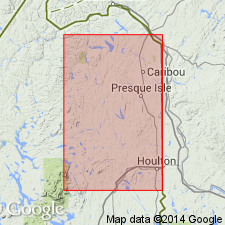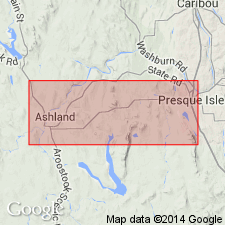
- Usage in publication:
-
- Ashland limestone
- Modifications:
-
- Original reference
- Dominant lithology:
-
- Limestone
- AAPG geologic province:
-
- New England province
Summary:
Pg. 21, 51, 52-54. Ashland limestone. Mainly pure gray limestone, much fractured. The fragmental, brecciated condition is common to it wherever seen. Contains fauna correlated with Niagara of New York. Appears to be younger than Ashland shales and older than Square Lake limestone.
Named from exposures in Ashland village (in a ledge opposite Ashland Hotel), Aroostook Co., northeastern ME.
Source: US geologic names lexicon (USGS Bull. 896, p. 80).

- Usage in publication:
-
- Anthony limestone†
- Modifications:
-
- Abandoned
- AAPG geologic province:
-
- New England province
Summary:
Pg. 170-172, 173-174; 1940 [abs.], GSA Bull., v. 51, no. 12, pt. 2, p. 1978-1979. †Ashland limestone included in Ashland formation (new). [See entry under Ashland formation.]
Source: US geologic names lexicon (USGS Bull. 1200, p. 151).
For more information, please contact Nancy Stamm, Geologic Names Committee Secretary.
Asterisk (*) indicates published by U.S. Geological Survey authors.
"No current usage" (†) implies that a name has been abandoned or has fallen into disuse. Former usage and, if known, replacement name given in parentheses ( ).
Slash (/) indicates name conflicts with nomenclatural guidelines (CSN, 1933; ACSN, 1961, 1970; NACSN, 1983, 2005, 2021). May be explained within brackets ([ ]).

